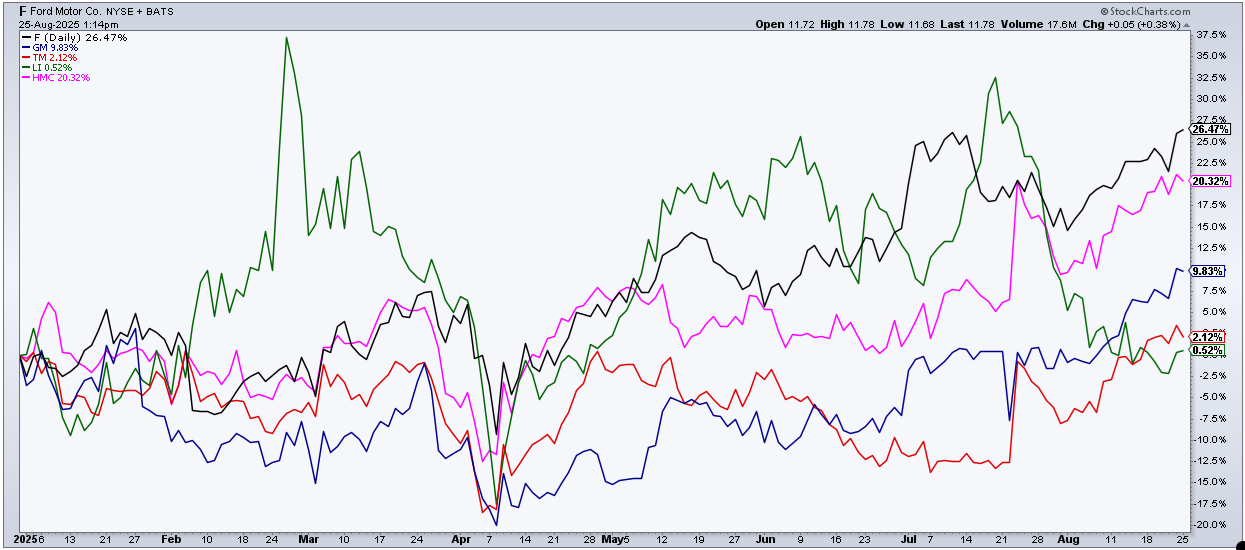- After tonight’s NVIDIA earnings report, inflation data will be the focus, particularly after last week’s dovish pivot from Fed Chair Powell at Jackson Hole
- As the month turns, key vehicle sales data from global automakers could set the tone, just as higher tariff rates penetrate the US economy
- Conference season also gets going in earnest, providing the latest industry-specific trends
earnings are the focus tonight, but investors’ attention will quickly shift back to the macro later this week. According to our Economic Calendar, with data licensed from Econoday Inc., a second read on Q2 GDP hits the tape Thursday morning. Within the report, key Personal Consumption Expenditure () data may confirm that the Federal Reserve still has work to do so that the PCE Price Index, the Federal Open Market Committee’s () favorite inflation gauge, retreats toward 2% annually.
Being a mere update, markets might not move all that much from the April-June data dump alone. But Friday’s July PCE release, which includes details on July’s consumer income and spending trends, could have a significant impact on whether the FOMC elects to resume cutting interest rates in September.
Inflation and the Fed
Three weeks from today, the FOMC is expected to drop its policy rate by a quarter of a percentage point—the first ease since last December. Friday’s PCE data and the following week’s onslaught of labor market indicators should dictate the Fed’s decision.
The September meeting will be one to watch, even aside from the policy rate, considering we’ll get a fresh set of the “dots,” also known as the Summary of Economic Projections. In the here and now, Fed Governor Waller, seen as a leading contender to replace Chair Powell, speaks at the Economic Club of Miami Thursday night.
The macro upshot? Thursday’s revision could be more interesting than impactful. Friday’s dataset is the one to watch.
Auto Production: A Pulse Check on Industry Momentum
It’s a busy back half of the week as far as the macro is concerned, while the start of September ushers in company-specific interim data that offer more granular details. Our team will be watching August auto production figures. While not as widely followed compared to GDP and PCE, it can be a bellwether for the so-called “real” economy, or labor-heavy and manufacturing-focused industries.
Recall last week that S&P Global’s US Purchasing Managers’ Index (PMI) survey revealed a three-year high in the “flash” August manufacturing sentiment; a final read will be released next month. The bulls hope that the PMI report will translate into firm domestic auto sales.
Here’s what to watch for: and serve up production and sales figures, respectively, on Friday. As US investors kick back on Labor Day, China’s provides August production totals. Li’s full Q2 earnings report crosses Thursday before the bell, so that could move the outperforming Chinese stock market as we wrap Q3’s middle month.
has the potential to be the most impactful on the Automobile Manufacturers industry within the Consumer Discretionary sector. Of course, rarely does a single monthly vehicle sales data point rattle the entire S&P 500® (unless reports a whopper or a dud). The point here is to use these data as pieces that form a macro mosaic. This patchwork could be made more visible after next Thursday, as Ford, along with Industrials-sector companies, is slated to present at the Jefferies Industrials Conference 2025 held in New York.
The Coming Wave of Conferences
Taking a step back, conference season indeed gets back into full swing after the three-day weekend. In July, we wrote our quarterly conference outlook, calling out which industry and investor events have the potential to reveal news and stir up sector-specific volatility.
At the company level, conferences commonly allow corporate managers to describe the latest demand trends and pressing issues. For the automakers, tariffs are the major x-factor in the expense section of the income statement right now.
Earlier this week, Goldman Sachs published a note pinpointing the specific hits from higher import duties. Ford commented that it delivered $2.1 billion in adjusted EBIT in Q2, despite an $800 million net tariff impact. , which only provides quarterly interim data (due out next in early October), recorded a $1.1 billion tariff expense.
Price Bucking the Worrisome Narrative
It sounds like bad news and tough times for the likes of Ford and GM, right? Price action in the stock market says otherwise.
Through August 25, Ford shares have returned 26%, beating GM, Honda, Toyota, and Li. The 2025 performance chart of those blue-chip auto stocks underscores that it has been an up-and-down ride for many quarters now.
Considering that the domestic OEMs carry significant debt, a lower Fed policy rate could positively impact the industry. This will probably be a hot topic at upcoming conferences, one that analysts hope to gain clarity on in the weeks ahead.
For investors, conference season can create pockets of volatility, particularly in sectors facing structural shifts driven by the macro and headlines out of the White House. Events over the ensuing weeks will be the first to occur after the new, higher August 7 reciprocal tariffs went into effect. Stock prices are lofty relative to April levels, so the expectations bar could be high at hotel ballrooms across the country. Source: Stockcharts.com
Source: Stockcharts.com
The Bottom Line
Taken in isolation, none of the upcoming events would rise to the level of a “make-or-break” moment for markets. Collectively, though, they add up to a sense check as the economy absorbs higher tariffs and a possibly more cost-conscious consumer.
Automakers’ interim data provide “hard” information on demand trends. Those reports are followed by “softer” commentary from CEOs and CFOs as the autumn’s conference season kicks into high gear.
This mix of data, industry trends, and corporate color could go a long way toward shaping how investors frame the often-volatile month of September.
